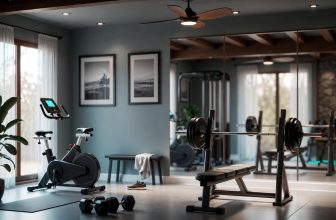Table of Contents
- Do Exercise Bikes Work?
- Effectiveness for Weight Loss
- Calorie Burn Across Bike Types
- Factors Impacting Calorie Burn
- Benefits Beyond Weight Loss
- Types of Exercise Bikes and Their Effectiveness
- Spin Bikes
- Upright Bikes
- Recumbent Bikes
- Optimizing Exercise Bike Workouts
- Practical Considerations
- FAQ
- Do exercise bikes help with weight loss?
- Are spin bikes better than recumbent bikes?
- How often should I use an exercise bike?
- Can exercise bikes improve heart health?
- Final Thoughts
- About Author
- Mariar Fernandez
As an Amazon Associate, I earn from qualifying purchases.
Do Exercise Bikes Work?
Do Exercise Bikes Work? Yes, exercise bikes work effectively for weight loss, cardiovascular health, muscle toning, and low-impact fitness, burning 200–600 calories per 30-minute session, depending on intensity and body weight.
Effectiveness for Weight Loss
Exercise bikes are highly effective for weight loss by creating a calorie deficit through cardiovascular exercise. The CDC recommends 150–300 minutes of moderate aerobic activity weekly, and bikes align well with this goal. A 2023 American College of Sports Medicine study found that a 150-pound person burns 200–400 calories in a 30-minute moderate cycling session, with vigorous efforts reaching 600 calories. Paired with a 500–750 calorie daily deficit, as per Mayo Clinic, this supports 1–2 pounds of weekly weight loss.
- Calorie Burn: High-intensity sessions maximize energy expenditure.
- Consistency: Indoor bikes enable year-round workouts.
- Low-Impact: Gentle on joints, encouraging longer sessions.
For weight loss strategies, see CDC’s Healthy Weight Guide.
Calorie Burn Across Bike Types
Calorie burn varies by bike type, intensity, and body weight. Harvard Medical School provides these 30-minute estimates:
| Weight | Spin Bike (Vigorous) | Upright Bike (Moderate) | Recumbent Bike (Moderate) |
|---|---|---|---|
| 125 lbs | 315–600 calories | 210–315 calories | 180–260 calories |
| 155 lbs | 390–720 calories | 260–390 calories | 220–325 calories |
| 185 lbs | 465–860 calories | 310–465 calories | 260–390 calories |
Factors Impacting Calorie Burn
- Intensity: High-intensity interval training (HIIT) boosts calorie burn by 20–30%, per a 2024 Journal of Sports Sciences study.
- Duration: Longer or short HIIT sessions (e.g., 15 minutes) optimize results, per Tufts University.
- Body Weight: Heavier individuals burn more calories.
- Bike Type: Spin and upright bikes engage more muscles, slightly outpacing recumbents.
Learn about HIIT at American College of Sports Medicine.
Benefits Beyond Weight Loss
Exercise bikes offer comprehensive health benefits:
- Cardiovascular Health: A 2023 American Heart Association study found cycling reduces heart disease risk by 15%.
- Muscle Toning: Targets quads, hamstrings, and glutes, enhancing strength without joint stress.
- Mental Wellness: Boosts endorphins, reducing depression risk by 20%, per Harvard Health.
- Joint-Friendly: Ideal for arthritis or injury recovery, per the Arthritis Foundation.
See more benefits at Arthritis Foundation’s Exercise Guide.
Types of Exercise Bikes and Their Effectiveness
Spin Bikes
Spin bikes are built for high-intensity workouts, mimicking outdoor cycling with weighted flywheels.
- Benefits: Burn 315–860 calories in 30 minutes, ideal for HIIT.
- Best For: Advanced users or those using virtual classes.
- Example: Peloton Bike+ ($2,495) – Features auto-resistance and 5,000+ classes.
Upright Bikes
Upright bikes engage core and lower-body muscles, offering a compact design.
- Benefits: Burn 210–465 calories in 30 minutes, suitable for moderate workouts.
- Best For: Space-conscious users seeking balanced intensity.
- Example: Schwinn IC4 ($799) – Offers 100 resistance levels and JRNY app.
Recumbent Bikes
Recumbent bikes prioritize comfort with a reclined seat and back support.
- Benefits: Burn 180–390 calories in 30 minutes, encourage longer sessions.
- Best For: Beginners, seniors, or those with joint issues.
- Example: NordicTrack Commercial VR25 ($1,999) – Includes iFIT and 26 resistance levels.
Explore top bikes at Consumer Reports.
Optimizing Exercise Bike Workouts
To maximize effectiveness, follow these strategies:
- Use HIIT: Alternate 30 seconds high resistance with 1 minute low resistance for 15–20 minutes. HIIT increases fat burn by 20%, per a 2024 study.
- Vary Intensity: Mix moderate (60–70% max heart rate) and vigorous (70–85%) sessions, per Harvard Health.
- Cycle Regularly: Aim for 4–5 weekly sessions of 30–45 minutes.
- Track Metrics: Use bike displays or apps like Strava for calorie and heart rate monitoring.
- Pair with Diet: A 500–750 calorie daily deficit supports weight loss, per Mayo Clinic.
For diet tips, visit Mayo Clinic’s Weight Loss Strategies.
Practical Considerations
- Set Goals: Target 1–2 pounds weekly weight loss or fitness improvements, per CDC guidelines.
- Choose Wisely: Select a bike based on space and needs (e.g., XTERRA FB150 for small homes).
- Maintenance: Wipe down frames and lubricate parts, per manufacturer instructions.
- Motivation: Use apps like Peloton or iFIT. “Classes keep me engaged,” says a Peloton user.
FAQ
Do exercise bikes help with weight loss?
Yes, they burn 200–600 calories per 30-minute session, effective when paired with a 500–750 calorie daily deficit.
Are spin bikes better than recumbent bikes?
Spin bikes burn more calories (up to 860 in 30 minutes) but recumbents encourage longer, joint-friendly sessions.
How often should I use an exercise bike?
Cycle 4–5 times weekly for 30–45 minutes at moderate to vigorous intensity for optimal results.
Can exercise bikes improve heart health?
Yes, cycling reduces heart disease risk by 15%, per a 2023 American Heart Association study.
Final Thoughts
Exercise bikes work effectively for weight loss, cardiovascular health, muscle toning, and mental wellness. Spin bikes maximize calorie burn, upright bikes balance intensity and space, and recumbent bikes suit joint-friendly workouts. Combine 4–5 weekly sessions, HIIT, and a balanced diet for optimal results. Choose a bike that fits your goals and lifestyle, and leverage apps to stay motivated.







